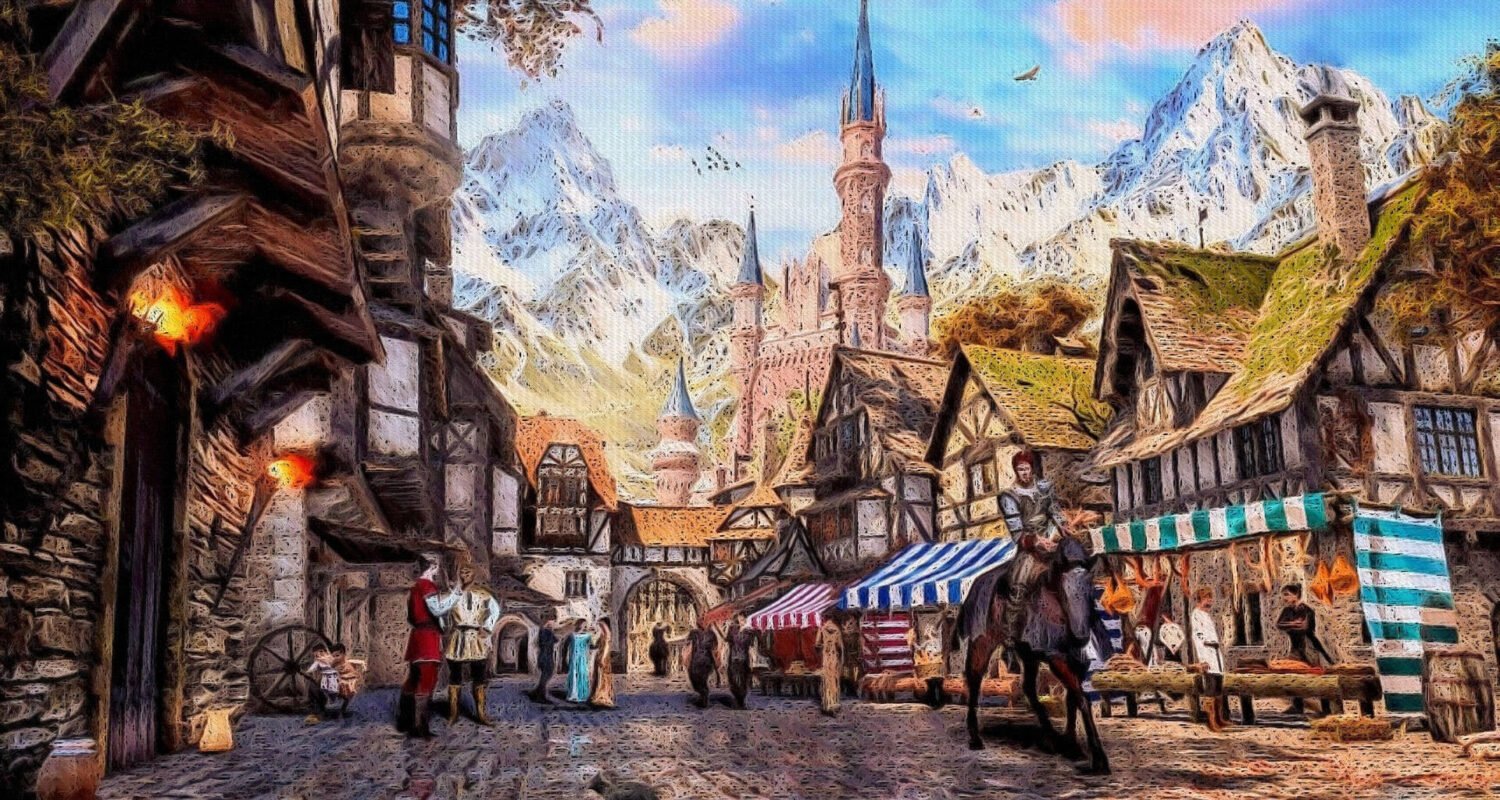
Guilds, Seals & Symbols: The Medieval Roots of Modern-Day Marketing Copy
Guilds, Seals & Symbols: The Medieval Roots of Modern-Day Marketing
In the grand tapestry of history, modern-day marketing has its most evident roots in the medieval era, where tools of trade, symbolism, and craftsmanship laid the foundations for the commercial strategies we know and use today. Long before the advent of lavish logos and compelling campaigns, medieval merchants wielded hammers and seals as symbols of authority and trust whilst gently carving their identities into the goods they traded. Medieval societies also demonstrated the power of guilds in their ability to manipulate product, price, promotion, and place as well as the crucial role of marketplaces in forging lasting relationships with customers. Hence, this article briefly explores how medieval guilds, marketplaces, and branding practices served as the foundation for modern marketing principles, highlighting their enduring influence on product regulation, consumer trust and competitive strategies.
Medieval Guilds: The Incubators of Business, Markets & Labour
Medieval guilds were essential institutions in shaping both the social and economic landscape of Europe, fostering business activities through structured apprenticeship and quality control systems. They were associations of craftsmen and merchants that collectively formed to propagate the economic interests of its members through mutual aid and support mechanisms. While the guilds were a standard fixture of Medieval Europe, their origins can be traced as far back into the Mesopotamian Age with more direct and evident roots in the Collegia of the Byzantine Era. Guilds were organised to function as both social and commercial entities and were thereby the engine rooms of business and marketing activities between the eleventh and sixteenth centuries. They were structured around a system of apprenticeship in which young males would be trained under a master for several years, without pay, before becoming a journeyman who worked in the trade in return for wages. Journeymen could become masters by producing a “masterpiece” to demonstrate their skill, and upon acceptance, they gained the right to run their own businesses and oversee the quality of other members’ work.
Guilds, with their monopolistic control and regulatory functions, played a paradoxical yet pivotal role in early market regulation, influencing the modern-day marketing strategies of product quality, pricing, distribution, and promotion. Their theologically driven, anti-competitive market philosophy demonstrated fluidity as they would usually leverage their monopolised power to restrict competition and regulate prices but at other times, they would consult merchants and drive entrepreneurial activity. In this way their role was almost paradoxical, emulating a combination of modern-day organisations from trade-unions to competition commissions and marketing consultancies. While today, individual firms would conduct their own marketing activities by manipulating the “4 Ps” of product, price, place and promotions, medieval guilds implicitly took control of all these procedures. They took this role by regulating the product quality of its craftsmen, influencing price by setting rates, controlling distribution through regionally monopolising their trade and promoting their goods by building reputation. Thus, guilds were an early, albeit complex, form of market regulation, blending protectionism with promotion to create a stable and thriving commercial ecosystem.
Bustling Markets & Town Squares: Real-Life Marketing Spectacles
While guilds were often like the strategy-makers of the day guiding the overall direction of the market and its participants, it was the blacksmiths, vendors and craftsmen that took a dominant role in the day-to-day marketing of their goods within bustling markets and town squares. Similar to today’s department stores, medieval markets followed an organised product layout by allowing similar goods like textiles and food to be placed into specific sections. Furthermore, similar to how supermarkets incentivise you to spend on goods placed at eye level or on aisles, medieval vendors would also compete for specific stations in which spending power was particularly high. For example, fresh produce may be sold at the centre of the market where people would eventually crowd together, and flowers and ornaments would be sold at exits and entrances where discretionary spending was high. This suggests that despite the anti-competitive direction set by guilds, real-life medieval markets were competitive spaces where profitability relied heavily on the customer acquisition skills of the vendors.
In an age in which mass media was absent from society, haggling, town-crying and visual signage was predominantly used to lure potential customers with price negotiations and bartering being common practice. This suggests that despite the price regulations set by guilds, customer interactions were what determined market prices and were in turn the primary factor that incentivised customer loyalty and relationships. Moreover, evidence also suggests that around the 12th century, French town criers were well known for heading into local pubs and taverns to flog their wares. Often, criers would offer free food samples from wooden casks for people to have a taste of in order to lure customers and build trust. These examples illustrate the genuine attempts used by the marketers of the day to build customer relationships that would eventually translate in the modern world through sophisticated and often digitised customer loyalty programs and reward systems.
Medieval marketplaces were hubs for cultural and social exchange, where people from all walks of life shared insights and innovations. These characteristics incentivised early merchants and artisans to acquire new customers through simple promotional gimmicks. For instance, in a manuscript by a scribe known as Herneis le Romanceur, he included a note that read: “If someone else would like a book as attractive as this, you can find me in Paris, across the road from the Notre Dame cathedral”. This note served as an early form of advertisement, inviting potential customers to seek out his services by pursuing a peripheral route of communication making. Similarly, a 15th-century scribe in Holland included a message in a copy of the Old Testament, saying: “If you liked this version of the Old Testament, I can also make you a copy of the New Testament.” These early messages show how medieval craftsmen and merchants used personal notes and recommendations to market their work, mimicking the functions of advertising and promotions today.
Logos & Branding: From Medieval Heraldry to Modern Marketing
In today’s competitive markets, branding involves unifying product elements into a singlecustomer idea often serving a multi-dimensional purpose. However, in the Medieval Age, branding stood for a singular purpose which was to create trust and confidence into the products traded functioning effectively as a risk mitigator in the minds of consumers. This purpose has been implied through legislative acts such King Henry III’s 1266 laws that required bakers to mark their bread with distinctive symbols to highlight authenticity. These symbols exhibit a preliminary example of trademarks that gradually evolved from being a mere risk mitigator to a complex tool used to enhance product differentiation. Notably, visual symbolism, frequently invoking theological themes and religious figures, was a pervasive strategy in medieval marketing, driven by the widespread illiteracy of the time and the centrality of religion in everyday life. The use of religious imagery proved highly effective in cultivating the trust and credibility necessary to outmanoeuvre competitors and establish authority in the marketplace.
While the strict guidelines on product uniformity by guilds disincentivised the use of branding, the growth in trade and competitive industries often propelled vendors to utilise symbols to differentiate their offerings and target customer segments. For example, medieval patterns from the French region of Saintonge were known to have hallmarked their pottery with distinctive green glaze alongside intricate geometric patterns to reinforce the luxury appeal and high quality of their products. This represents a deliberate effort by artisans to reposition their products and target wealthier consumers akin to the brand propositions used by luxury giant, Louis-Vuitton, Moët, Hennessy (LVMH) today. Similarly, swordsmiths from Toledo, Spain, stamped their blades with religious symbols that guaranteed strength and durability as well as to promote the region’s comparative advantage towards sword-making. These swordsmiths’ brand aspirations would have been fulfilled as countless Toledo swords were discovered in much of Europe and the Islamic world, indicating the global appeal of their successful brand. Through this narrative, we see the evolution of branding as increasing competition which spurred medieval vendors to establish distinct and individual identities. Consequently these vendors redefined branding from being a mere mitigator of risk to a powerful tool of differentiation.
Protection of Brand Integrity: From Medieval Counterfeiting to Modern Brand Safeguarding
Medieval branding practices led to foundational developments in industrial property laws, an early predecessor to the intellectual property and trademark laws that govern the conduct of firms today. These laws were first discussed by Italian jurist Bartolo da Sassoferrato, who, in the 14th century, wrote the first treatise on trademark law. The implication of these laws meant that marks were no longer optional for medieval guilds and artisans as they were monitored by local government in a manner that prevented counterfeit goods. The punishments for selling counterfeit goods in medieval times were severe, reflecting the importance of maintaining product authenticity. In the modern world, protecting brand integrity is equally critical. Brands like Nike and Louis Vuitton invest heavily in intellectual property laws, monitoring counterfeit goods and ensuring that their brand’s quality remains undiluted by imitation products. This modern approach to brand protection builds upon the principles of medieval market regulation, where ensuring quality and preventing fraud were key to maintaining trust and business success.
As explored through this article, the medieval period laid the groundwork for many of the marketing strategies and practices we use today. While the techniques and connections may extend beyond the middle-ages, they incentivise us to appreciate and acknowledge the humble roots of commercial concepts, like marketing, that are often perceived as products of the industrial age. From the role of guilds in regulating quality and price to the early use of theological symbols and product markers to build trust, the approach to business in the medieval era resonates with activities of modern-day businesses. As we look at the evolution from medieval practices to modern-day marketing, the desire to build trust, establish authority and create consumer loyalty has remained at the core of commercial activity across centuries and is one that accentuates with increasing competition. In this way, this analysis has reiterated the foundational customer-centric philosophy of marketing and how it is grounded in driving value creation and forging lasting relationships with customers.
Bibliography
Bastos, W., & Levy, S. J. “A History of the Concept of branding: Practice and Theory.” Journal of Historical Research in Marketing 4, no.3 (2012): 347–368. https://doi.org/10.1108/17557501211252934
Bosshardt, W., & Lopus, J. “The Economics of World History – Business in the Middle Ages: What Was the Role of Guilds?” Social Education 77, no.2 (2013): 64-67. https://www.socialstudies.org/system/files/publications/articles/se_77021364.pdf
Callum. “The History of Logos – Where Do They Come From?”Creato. Published April 13, 2023. https://creato.com.au/blog/history-of-logos/
Duignan, B. “guild | trade association.” Encyclopædia Britannica. Revised 2019. https://www.britannica.com/topic/trade-union
E. Novak, R. “What is a trademark?” The Law Offices of Richard E. Novak, LLC. Published June 7, 2018. https://www.richardnovaklaw.com/intellectual-property/trademarks/what-is-a-trademark/
Fisher, M. “The Birth of Branding: Trademarks and Craft Guilds in Medieval Europe.” Medium. Published November 18. https://medium.com/@martinifisher/the-birth-of-branding-trademarks-and-craft-guilds-in-medieval-europe-8ff9f413432e
Hill, S. S. “History of the Quality Management System.” Arena. Published June 22, 2022. https://www.arenasolutions.com/blog/history-of-the-quality-management-system/
Jam, C., & Tallobre, J. “A short history of brands: from Antiquity to the present day.” Dépôt De-Marque.com. Published October 4, 2018. https://depot-de-marque.com/en/a-brief-history-of-brands-1/
McCracken, G. “Medieval Marketing.” Harvard Business Review. Published October 20, 2011. https://hbr.org/2011/10/medieval-marketing
McIntosh, M. “Medieval Marketing; Advertising Techniques from the Middle Ages Still Used Today.” Brewminate: A Bold Blend of News and Ideas. Published August 14, 2023. https://brewminate.com/medieval-marketing-advertising-techniques-from-the-middle-ages-still-used-today/
Mcquarrie, E. F., & Phillips, B. J. Visual branding: a rhetorical and historical analysis. Edward Elgar Publishing, 2016.
Medie World Warehouse. “Medieval Marketplaces: A Glimpse into the Past.” MedieWorld. Published November 5, 2023. https://medieworld.com/blog/medieval-marketplaces-a-glimpse-into-the-past/











Leave a Comment